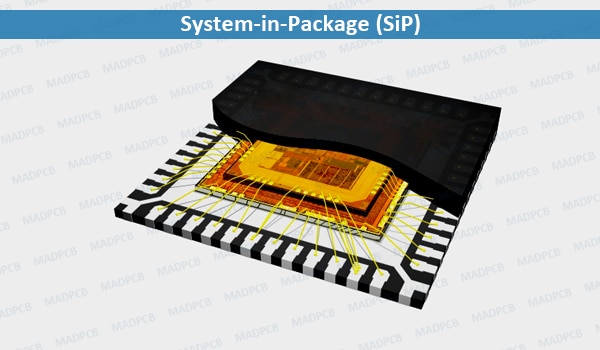What’s System-in-Package (SiP)?
System-in-Package (SiP) is a number of integrated circuits (IC) enclosed in one or more chip carrier packages that may be stacked using package on package. The SiP performs all or most of the functions of an electronic system, and is typically used inside a mobile phone, digital music player, etc. Dies containing integrated circuits may be stacked vertically on a substrate. They are internally connected by fine wires that are bonded to the package. Alternatively, with a flip chip technology, solder bumps are used to join stacked chips together. A SiP is like a system on a chip (SoC) but less tightly integrated and not on a single semiconductor.
SiP dies can be stacked vertically or tiled horizontally, unlike less dense multi-chip modules, which place dies horizontally on a carrier. SiP connects the dies with standard off-chip wire bonds or solder bumps, unlike slightly denser three-dimensional (3D) integrated circuits (ICs) which connect stacked silicon dies with conductors running through the die.
Many different 3D packaging techniques have been developed for stacking many fairly standard chip dies into a compact area.
An example System-in-Package can contain several chips-such as a specialized processor, DRAM, flash memory-combined with passive components-resistors and capacitors-all mounted on the same substrate. This means that a complete functional unit can be built in a multi-chip package, so that few external components need to added to make it work. This is particularly valuable in space constrained environments like MP3 players and mobile phones as it reduces the complexity of the printed circuit board (PCB) and overall design. Despite its benefit, this technique decreases the yield of fabrication since any reduces the complexity of the circuit board and overall design. Despite its benefits, this technique decreases the yield of fabrication since any defective chip in the package will result in a non-functional packaged integrated circuit, even if all other modules in that same package are functional.
SiPs are in contrast to the common system on a chip (SoC) integrated circuit architecture which integrates components based on function into a single circuit die. An SoC will typically integrate a CPU, graphics and memory interfaces, hard-disk and USB connectivity, random-access and read-only memories (ROMs) and secondary storage and/or their controllers on a single die, whereas a SiP would connect these modules as discrete components in one or more chip carrier packages. A SiP has a lower grade of integration in comparison to a SoC.
SiP technology is primarily being driven by early market trends in wearables, mobile devices and the internet of things (IoTs) which do not demand the high numbers of produced units as in the established consumer and business SoC market. As the internet of things becomes more of a reality and less of a vision, there is innovation going on at the system on a chip and SiP level so that microelectromechanical (MEMS) sensors can be integrated on a separate die and control the connectivity.
SiP solutions may require multiple packaging technologies, such as flip chip, wire bonding, wafer-level packaging (WLP) and more.
Some SiP Suppliers
- Amkor Technology
- Atmel
- Cypress Semiconductor
- Toshiba
- Renesas
- SanDisk
- Samsung
- Silicon Labs
- Nordic Semiconductor

